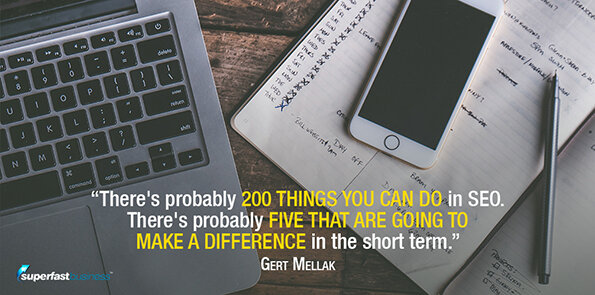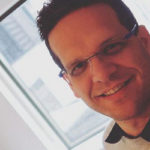SEO is not something you set and forget. Our guest expert Gert Mellak is back to discuss why SEO is an ongoing activity.
Tune in and discover the factors that make up his SEO process and get continuing results for his clients.
Podcast: Download (Duration: 36:12 — 33.3MB)
Get Notified Of Future Episodes Apple Podcasts | Spotify | Amazon Music | Android | Blubrry | Gaana | TuneIn | Deezer | Anghami | RSS | More
In the podcast:
02:03 – Why SEO is an ongoing process of improvement
07:12 – The changing user behavior that impacts SEO
11:23 – Transcriptions and the matter of rankability
12:49 – Introducing ERICA
14:22 – How are things evolving?
15:39 – What SEO has a whole lot of
17:17 – The importance of interlinking
19:01 – Why do people come to your site?
22:55 – Ranking involves a lot of buckets
24:41 – What a podcast post would ideally look like
29:18 – The action steps that will have impact
30:23 – A huge development in the ERICA process
34:24 – Summing things up
Get your business into top working order with help from James
SEO Leverage’s Gert Mellak has been on SuperFastBusiness several times, in each appearance tackling a different aspect of SEO. This time he and James delve into the ongoing nature of search engine optimization.
“SEO never sleeps, it’s not a done-and-finished type activity.”
As Gert will tell you, SEO is not a done-and-finished activity. And James will concur, having once owned an SEO business himself. The field involves constant research and development. What ranks today is the standard of the moment, and will likely be different in a year, or even a month’s or a week’s time.
 Gert currently guides SuperFastBusiness’s SEO, and in the process there’s always a new target, always something new to focus on, whether it’s page speed, or an article slipping in rank.
Gert currently guides SuperFastBusiness’s SEO, and in the process there’s always a new target, always something new to focus on, whether it’s page speed, or an article slipping in rank.
Why SEO is an ongoing process of improvement
So why the need for non-stop optimization? Gert explains with a scenario he’s seen time and again.
The client has been in the content game for years. They’ve been smart enough to hire guidance, giving them detailed instructions of pain points, questions and topics to focus on. Over time, they’ve built up a content base of maybe 500, 1500 articles.
A few years back those articles did very well, because the SEO landscape was completely different. Google had different standards of what they considered good SEO. So now those sites have a lot of content that was very good. But compared with users’ current expectations, it just doesn’t measure up.
For instance, five or six years ago you could publish a content with no image or formatting. And because the content is good, it could still rank very well. If it got engagement comments and social shares, it could even land on page one.
Today, a text-only page with no sub headlines, no formatting, no styling, images, video or audio, would compare very poorly with what users expect.
Google wants to make users happy. And if a user, landing on that page, goes back to search and picks a different result, Google figures they weren’t satisfied.
This means we need a good understanding of what, in our industry – and even on specific search queries – Google wants to present to users. This can change over time. Hence, the need for SEO on an ongoing basis, ensuring that one’s entire content base is up to the standard users will appreciate.
The matter of rankable material
Taking SuperFastBusiness posts as an example, we have been publishing podcasts for 10 years. Our basic post framework hasn’t changed much – podcast audio, bullet points, and transcription. Are we perhaps behind the times? Should we still do transcriptions? Or would a content-rich article and show notes be better in terms of SEO?
“Not everything we put up on a website is rankable material.”
Gert’s response is, not everything that goes on a website is rankable material. His advice is to filter what we want Google to index.
A few years back, a transcription was fine and could rank very well, because there wasn’t much competition. Over time, though, what happens on podcast sites is that episodes and transcriptions become similar, because of the few main topics commonly talked about. It becomes hard then for Google to differentiate.
If you’ve got two episodes about email marketing, with a transcription for each, which should Google rank? This is where we need to help Google a bit. Because if they pick the one that’s not optimized, you may rank on page five, whereas if they picked the optimized one, you could be on page one.
Knowing what Google wants is also key. If you think the podcast (in SEO, basically an audio add-on) plus some show notes and a transcription are rankable material, you may need to reconsider. Google wants to make users happy. Not just podcast listeners, not just readers. And if it comes down to reading, there are more pleasurable things to do than read a transcription.
So should we do a condensed article instead of transcriptions? Gert suggests having both. A fully-featured article, an audio, the transcription as a download, a video if there is one.
The ERICA framework
A framework is a good thing to go by if you want to maintain quality. So for ongoing client SEO work, Gert and his team apply a process they’ve called ERICA.
ERICA is an acronym for the steps they walk their clients through every couple of weeks in their consulting. It is broken down as follows:
E – Evolution
This is where they make sure the client knows their current SEO status. They focus on conversions, which Gert says, at the end of the day, is what really counts, over traffic. What are the conversions that come in through the different channels? And what’s the evolution of this?
 At the same time, what are the main competitors doing? Note: your competitors online aren’t necessarily the competitors you have in mind. There are competitors their clients may not be following, but that show up in every single top 10 result in Google. They may not even have the same business model, but they are a competitor because they have content Google wants to rank.
At the same time, what are the main competitors doing? Note: your competitors online aren’t necessarily the competitors you have in mind. There are competitors their clients may not be following, but that show up in every single top 10 result in Google. They may not even have the same business model, but they are a competitor because they have content Google wants to rank.
R – Research
If there’s something SEO involves a lot of, it’s research. Like any good SEO agency, SEO Leverage has an R&D department. They spend a lot of time testing SEO theories and SEO ideas, confirming what Google tells them, which is not necessarily in every industry applicable.
They are always running at least five tests every week, to stay on top of what’s happening. They then redo those tests over time, because some findings might be different. Research also includes competitive research, research on the site, what can be done, everything from user experience.
They focus a lot on conversion, researching call to action. (A client of theirs has doubled conversions just by adding a call to action after the second paragraph on the page.)
They check how a site functions on devices, sometimes doing usability tests on mobile. This is important, considering most sites these days have at least 60 or 70 percent mobile traffic.
I – Interlinking
Linking, both internal and external, still play a big role in SEO.
Gert suggests creating content silos or clusters, basically a main article with specific or supporting articles linked to them. This creates a content structure Google can understand and readily send users into. In such an arrangement, users are very likely to find what they need, even if Google hasn’t 100 percent clarity about the search intent.
 External links are harder to achieve, but they are still important. Gert’s team have a contact base of site owners that they add to with every new client. This network is how they get high quality, relevant links to their clients’ sites, just the signal Google wants to see. It’s one thing that you have the best content. It’s another thing if others confirm this by linking to your site.
External links are harder to achieve, but they are still important. Gert’s team have a contact base of site owners that they add to with every new client. This network is how they get high quality, relevant links to their clients’ sites, just the signal Google wants to see. It’s one thing that you have the best content. It’s another thing if others confirm this by linking to your site.
C – Content
Content is king, the reason anyone visits a site in the first place. And in SEO, it involves more than what you have to say.
In terms of content, Gert points out design as a highly relevant factor in whether or not someone reads your stuff. People coming to your website will get an overall impression from the way it looks. Then they decide to read a headline, a couple of sentences, and so forth. If the design is poor, they may just hit the Back button.
As far as the actual material, if you know your audience, you probably know what they’re interested in. However, just writing about what they’re interested in doesn’t mean people are going to come. You want to write about something they really search for. And you want to write about something in a way that Google wants to rank.
This is where people often ask, what’s the best SEO tool out there? Very often, says Gert, it’s simply Google. If, for instance, you want to rank for “best SEO agency“, you simply type the term into Google and see what ranks. Then you evaluate: Can I produce a similar piece of content? Can I emulate the kind of links these pages get? Is this only a list of sites that have been around for 20 years?
A – Action steps
With SEO Leverage, clients get a call twice a month. And at the end of each call, they have a list of action steps. This shows them what the team will do for them in the next two weeks, and what they should be working on, based on what the high-impact things are that they can immediately do.
 Gert says there are probably 200 things you can do in SEO. There’s probably five that are going to make a difference in the short term. If you’re not an image-focused business, placing 1500 alternative texts on your site’s images is probably not a high-impact undertaking. You’re better off creating content.
Gert says there are probably 200 things you can do in SEO. There’s probably five that are going to make a difference in the short term. If you’re not an image-focused business, placing 1500 alternative texts on your site’s images is probably not a high-impact undertaking. You’re better off creating content.
The development that’s got Gert excited
It used to be SEO Leverage would keep clients on top of things with spreadsheets, links, screenshots and the like. That’s all about to change.
A year of thinking and several months of development have gone into making the agency’s very own ERICA web application. Clients will be able to log into one single place and access a dashboard that tells them every day what’s happening SEO-wise. They’ll see software updates, status, competitors’ performance, high-impact steps to follow.
If a ranking drops, they’ll know. They can ask questions, and the team can notify them about what’s been done. Likewise, if the client revises something, the team will be updated. Actions can be documented and results reviewed.
It’s something no SEO agency has, it’s the payoff of months of hard work, and is coming out this month. Gert and his team are understandably stoked.
Summing things up
SEO is essentially a moving target. Whatever is working today is great, but keep an eye out for what you want to be working tomorrow. That said, if you have a dashboard that shows you when things are starting to change, you can respond quickly. And if you have regular check-in with a proper SEO pro, you can’t slide too badly. (Just don’t expect guarantees. As Gert puts it, any SEO agency giving guarantees is lying to you.)
“Any SEO agency giving guarantees is lying to you.”
SuperFastBusiness is grateful to have Gert Mellak, not just as a guest on the podcast but as the consultant for its current SEO. If you’re just starting out with SEO, you may want to check out his book, The ERICA Framework, on Amazon.
Find the world-class experts your business needs inside JamesSchramko membership
Need help with your SEO? Contact Gert and his team at SEOLeverage.com
Liked the show? Leave us a review on iTunes










James, What is the name of your wife’s business that you mentioned in this podcast?
Hi Jason,
http://www.VisionFind.com